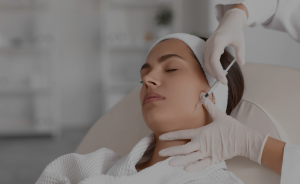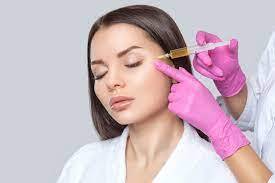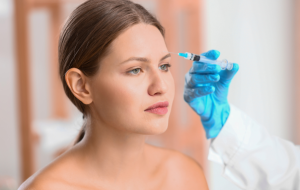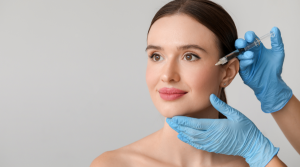What is Botox?
Botox is an injectable neurotoxin. It reduces wrinkles and treats conditions like lazy eye and neck spasms.
It can even address overactive bladder. Like Botox, other brands also use botulinum toxin. They include Daxxify, Dysport, Jeuveau, Myobloc, and Xeomin.
In this blog we’ll take a look at aftercare after botox treatment.

How Does Botox Work?
Botox blocks nerve signals. This stops muscle contractions that cause wrinkles and prevents new ones.
Diverse Applications of Botox
It is a natural substance, and It has over 50 years of medical use. Its benefits extend beyond wrinkle treatment. Botox has been in use since 2002. Its known for its efficacy for forehead wrinkles and frown lines. It also offers safe treatment for medical conditions, including:
- Lazy eye (strabismus)
- Wry neck and neck spasms (cervical dystonia)
- Excessive sweating (hyperhidrosis)
- Migraine headaches
- Overactive bladder
- Muscle contractions associated with cerebral palsy

Mitigating Risks
Botox comes from bacteria. But, it is safe in the right doses, when given by experienced professionals. Complications like muscle weakness, bladder issues, or vision problems are rare when given under proper medical supervision.
Preparation and Communication
Before undergoing Botox treatment, thorough communication with your healthcare provider is crucial. Discussing past medical history is key. This ensures a treatment plan tailored to your needs and expectations.
Procedure Overview
Botox treatment is painless and performed while the patient is awake. The process generally involves:
- Cleaning the treatment areas with an antiseptic solution.
- Numbing the areas using topical anesthetic cream, ice, or vibration.
- The doctor administers injections with a fine needle. They do so in a strategic pattern, targeting specific muscles.
- Applying pressure to injection sites to minimize bleeding and bruising.
- Allowing the patient to rest upright for a few minutes post-injection.

Preparing for Botox
Before your Botox appointment, don’t drink for 24 hours. Also, avoid blood-thinning meds like aspirin or ibuprofen. This will cut the risk of redness and bruising.
Understanding the Effects
Botox begins to work about 3 days after injection. Full results appear about 2 weeks later. Its effects last 3 to 6 months.
Wrinkles may return after that. You may require more injections for lasting results.
Potential Risks and Safety
Botox is generally safe. But, it may cause minor side effects like headaches, swelling, or flu-like symptoms. Serious side effects, like eye drooping or breathing trouble, are rare. If you experience any of these side-effects contact your doctor immediately.
The Botulism Myth
Contrary to popular belief, botulism infection from Botox is rare. Doctors use the botulinum toxin in cosmetic procedures. It undergoes rigorous lab development to ensure sterility and safety.

Aftercare
After a injection, you must follow proper aftercare instructions. Avoid exercise for at least 3 hours after treatment.
Also, avoid facials, head massages, or putting pressure on the treated area for 24 – 48 hours. Don’t lie down for an hour, and avoid saunas, hot tubs, or tanning booths for 4 hours. This will cut the risk of bruising.
Post-Treatment Care
Your skincare professional at Beauty Aesthetics in Toronto will give you detailed botox aftercare instructions. These will help you get the most from your treatment.
Cold Compresses Are Beneficial
Putting a cold compress on injected areas can relieve pain and reduce swelling. This helps to ease common side effects like bruising.

Facial Exercises Post-Treatment
Doing facial exercises helps distribute Botox in muscles. These include frowning, squinting, smiling, and raising eyebrows.
Avoid Physical Activity
Don’t do strenuous exercise for at least 24 hours after treatment. This prevents Botox from spreading and lowers the risk of swelling or bruising.
Cosmetic Restraints
Avoid applying cosmetics for the rest of the day after treatment. This prevents Botox from spreading to unintended areas and makes treatment work better.
Posture Matters
Avoid lying down or leaning forward for 4 hours after treatment. This prevents Botox from spreading and reduces bruising.
Sun Protection is Key
Reduce sun exposure. Avoid hot places like saunas or hot tubs for 24 hours after treatment. This prevents Botox from moving due to heat. Also, avoid rubbing or touching your face.
Medication Considerations
Discomfort after treatment is usually minimal. But, before treatment, avoid blood-thinning drugs like aspirin or ibuprofen, or blood pressure medication.
Contact your doctor immediately if you experience any unusual symptoms after treatment. Avoid alcohol, since it can thin the blood and delay the effects of botox kicking in.
Conclusion
Healthcare providers do Botox injections on an outpatient basis. They do not need anesthesia, but may use local anesthesia or numbing cream for comfort. The procedure involves multiple injections. They target specific facial muscles and take around 15 minutes on average.
Costs vary based on factors. These include location, the amount of product used, and practitioner expertise.
At Beauty Aesthetics in Toronto, our skilled practitioners ensure a comfortable Botox treatment. They prioritize safety and good results.
Contact us today to schedule a consultation. You will discover the transformative power of Botox. It goes beyond reducing wrinkles.






